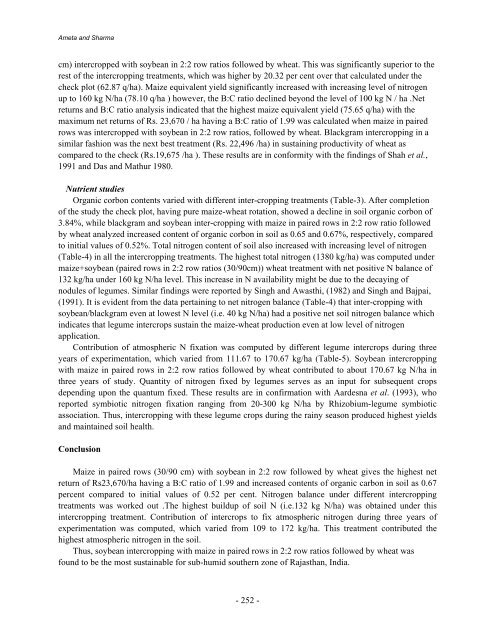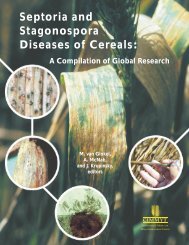Section 3 (Crop Management)
Section 3 (Crop Management)
Section 3 (Crop Management)
Create successful ePaper yourself
Turn your PDF publications into a flip-book with our unique Google optimized e-Paper software.
Ameta and Sharma<br />
cm) intercropped with soybean in 2:2 row ratios followed by wheat. This was significantly superior to the<br />
rest of the intercropping treatments, which was higher by 20.32 per cent over that calculated under the<br />
check plot (62.87 q/ha). Maize equivalent yield significantly increased with increasing level of nitrogen<br />
up to 160 kg N/ha (78.10 q/ha ) however, the B:C ratio declined beyond the level of 100 kg N / ha .Net<br />
returns and B:C ratio analysis indicated that the highest maize equivalent yield (75.65 q/ha) with the<br />
maximum net returns of Rs. 23,670 / ha having a B:C ratio of 1.99 was calculated when maize in paired<br />
rows was intercropped with soybean in 2:2 row ratios, followed by wheat. Blackgram intercropping in a<br />
similar fashion was the next best treatment (Rs. 22,496 /ha) in sustaining productivity of wheat as<br />
compared to the check (Rs.19,675 /ha ). These results are in conformity with the findings of Shah et al.,<br />
1991 and Das and Mathur 1980.<br />
Nutrient studies<br />
Organic corbon contents varied with different inter-cropping treatments (Table-3). After completion<br />
of the study the check plot, having pure maize-wheat rotation, showed a decline in soil organic corbon of<br />
3.84%, while blackgram and soybean inter-cropping with maize in paired rows in 2:2 row ratio followed<br />
by wheat analyzed increased content of organic corbon in soil as 0.65 and 0.67%, respectively, compared<br />
to initial values of 0.52%. Total nitrogen content of soil also increased with increasing level of nitrogen<br />
(Table-4) in all the intercropping treatments. The highest total nitrogen (1380 kg/ha) was computed under<br />
maize+soybean (paired rows in 2:2 row ratios (30/90cm)) wheat treatment with net positive N balance of<br />
132 kg/ha under 160 kg N/ha level. This increase in N availability might be due to the decaying of<br />
nodules of legumes. Similar findings were reported by Singh and Awasthi, (1982) and Singh and Bajpai,<br />
(1991). It is evident from the data pertaining to net nitrogen balance (Table-4) that inter-cropping with<br />
soybean/blackgram even at lowest N level (i.e. 40 kg N/ha) had a positive net soil nitrogen balance which<br />
indicates that legume intercrops sustain the maize-wheat production even at low level of nitrogen<br />
application.<br />
Contribution of atmospheric N fixation was computed by different legume intercrops during three<br />
years of experimentation, which varied from 111.67 to 170.67 kg/ha (Table-5). Soybean intercropping<br />
with maize in paired rows in 2:2 row ratios followed by wheat contributed to about 170.67 kg N/ha in<br />
three years of study. Quantity of nitrogen fixed by legumes serves as an input for subsequent crops<br />
depending upon the quantum fixed. These results are in confirmation with Aardesna et al. (1993), who<br />
reported symbiotic nitrogen fixation ranging from 20-300 kg N/ha by Rhizobium-legume symbiotic<br />
association. Thus, intercropping with these legume crops during the rainy season produced highest yields<br />
and maintained soil health.<br />
Conclusion<br />
Maize in paired rows (30/90 cm) with soybean in 2:2 row followed by wheat gives the highest net<br />
return of Rs23,670/ha having a B:C ratio of 1.99 and increased contents of organic carbon in soil as 0.67<br />
percent compared to initial values of 0.52 per cent. Nitrogen balance under different intercropping<br />
treatments was worked out .The highest buildup of soil N (i.e.132 kg N/ha) was obtained under this<br />
intercropping treatment. Contribution of intercrops to fix atmospheric nitrogen during three years of<br />
experimentation was computed, which varied from 109 to 172 kg/ha. This treatment contributed the<br />
highest atmospheric nitrogen in the soil.<br />
Thus, soybean intercropping with maize in paired rows in 2:2 row ratios followed by wheat was<br />
found to be the most sustainable for sub-humid southern zone of Rajasthan, India.<br />
- 252 -









